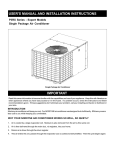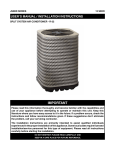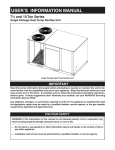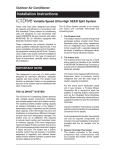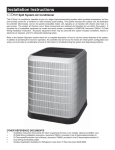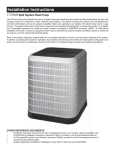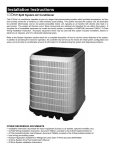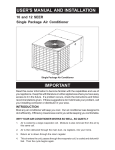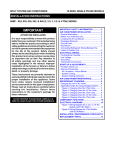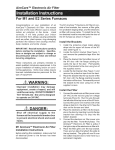Download USER`S MANUAL AND INSTALLATION - eNora
Transcript
USER'S MANUAL AND INSTALLATION INSTRUCTIONS P3B (A,C) Series 10 and 12 SEER Single Package Air Conditioner IMPORTANT Read this owner information to become familiar with the capabilities and use of your appliance. Keep this with literature of other appliances where you have easy access to it in the future. If a problem occurs, check the instructions and follow recommendations given. If these suggestions don’t eliminate your problem, call your installing contractor or distributor in your area. INTRODUCTION Most any air conditioner will keep you cool. Our air conditioner was designed to do it efficiently. Efficiency means less cost to you while keeping you comfortable. WHY YOUR AIR CONDITIONER WORKS SO WELL, SO QUIETLY 1. Air is cooled by a large evaporator coil. Moisture is also removed from the air by this same coil. 2. Air is then delivered through the main duct, via registers, into your home. 3. Return air is drawn through the return grille. 4. This air enters the unit, passes through the evaporator coil, is cooled and dehumidified. Then the cycle begins again. SECTION 1. OWNER INFORMATION OPERATING INSTRUCTIONS To Turn On Air Conditioner 1. 2. 3. Set the system switch to "Cool." Set the thermostat at the temperature level you desire. Your air conditioner should start as soon as room temperature rises above the setting on the thermostat. To Shut Off Air Conditioner 1. 2. Turn the system switch to "Heat" or "Off." Turn the thermostat to the desired heating temperature setting. BEFORE YOU CALL A SERVICEMAN Check your system at the start of each air conditioning season. Make sure it's working right, clean or change filters and make any needed adjustments. In addition, follow these simple rules: 1. Never run your system without a filter. If you do, the cooling coils will collect dirt and may become clogged. 2. Set your thermostat at the comfort level you wish -- and then leave it alone. Let it control the operation of the air conditioning system. If you get chilly, turn it up a degree at a time until comfort is restored. 3. It takes longer for an air conditioner to cool your dwelling than it does for your furnace to heat it. So . . . don't turn the unit on and expect a dramatic drop in temperature, at least not right away. If your home is hot and humid, the temperature will drop slowly. 4. Check your filters every 30 days in summer to see if they are dirty. To keep them clean, use a mild solution of detergent and water on washable types. Replace non washable filters. 5. Keep your outdoor condenser coil clean. You can hose it down when it gets dirty. If your air conditioner isn't working: 1. Make sure the fuses are not blown or that your circuit breakers are on. 2. See that your thermostat is set at the desired temperature and that your system's switch is on "Cool." 2 3. 4. For best air flow, make sure your return grille is not covered and that the filter is clean. Check the outdoor condenser coil and make sure it is clean and not clogged with grass or leaves. If your air conditioner still isn't working, call your nearest distributor. SECTION 2. INSTALLER INFORMATION GENERAL Read the following instructions completely before performing the installation. These instructions are for the use of qualified personnel specially trained and experienced in the installation of this type of equipment and related system components. Some states require installation and service personnel to be licensed. Unqualified individuals should not attempt to interpret these instructions or install this equipment. The single packaged air conditioners are designed for outdoor installation only and can be readily connected into the high static duct system of a home. The only connections needed for installation are the supply and return ducts, the line voltage, and thermostat wiring. The single package air conditioner is completely assembled, factory wired, and factory run tested. The units are ready for easy and immediate installation. PRE-INSTALLATION CHECK Before any installation is attempted, the cooling load of the area to be conditioned must be calculated and a system of the proper capacity selected. It is recommended that the area to be conditioned be completely insulated and vapor sealed. The installer should comply with all local codes and regulations which govern the installation of this type of equipment. Local codes and regulations take precedence over any recommendations contained in these instructions. Consult local building codes and the National Electrical Code (ANSI CI) for special installation requirements. The electrical supply should be checked to determine if adequate power is available. If there is any question concerning the power supply, contact the local power company. Inspecting Equipment: All units are securely packed at the time of shipment and, upon arrival, should be carefully inspected for damage. Claims for damage (apparent or concealed) should be filed immediately with the carrier. ! CAUTION: Do not tip the unit on its side. Oil may enter the compressor cylinders and cause starting trouble. If unit has been set on its side, restore to upright position and do not run for several hours. Then run unit for a few seconds. Do this three or four times with five minutes between runs. INSTALLATION (For Platinum Series ready homes) 3. INSTALL THE RETURN AND SUPPLY AIR FITTINGS ON THE UNIT 1. The supply and return fittings are shipped in the supply duct. They attach to the unit openings with a flange and bead arrangement, secured with two sheet metal screws. Note: For ease of access, install fitting before positioning unit in final location. LOCATE THE 40 AMP BRANCH CIRCUIT DISCONNECT RECEPTACLE AND DISCONNECT COVER LOCATED OUTSIDE ON ONE OF THE OUTER WALLS OF THE HOME. Locate the unit within the reach of the Power Cord assembly and branch circuit receptacle. • Create a solid, level position, preferably on a concrete slab or plastic pad (use NORDYNE P/N-903897 or equivalent) and slightly above grade level, located where the skirting channel across top of unit is directly under bottom edge of wall. (See Fig. 1) • Minimum clearances to obstructions. (See Fig. 1) SUPPLY DUCT Position the supply duct collar so the edge of the unit openings fit between the flange and the bead. Overlap the collar ends keeping the small screw holes underneath. Align the holes in the crimped area and install one screw. Tap collar as necessary to ensure engagement with unit opening and install second screw. Tighten first screw. 2. UNPACK THE UNIT DUCTING SYSTEM It is recommended that the unit be unpacked at the installation site to minimize damage due to handling. DUCT REQUIREMENTS a. Remove the bands from around the unit. b. Unfold the top and bottom cap flanges. c. Carefully remove the top cap and tube. 6 ft. 24" THE AIR OUTPUT OF THE SYSTEM WILL NOT CONDITION THE HOME IF THE AIR IS LOST TO THE OUTSIDE THROUGH LEAKS 12" Skirting Channel 12" Dia. 12" Dia. Supply Air To Main Ducts (2) 36" 12" Figure 1. Minimum Unit Clearances Supply Air From Furnace 14" Dia. Figure 2. Supply Air Fittings 3 IN THE DUCT SYSTEM. ALSO, DUCTS WHICH ARE COLLAPSED OR RESTRICTED BY FOREIGN OBJECTS WILL PREVENT ADEQUATE AIR FLOW. CONNECTING THE RETURN AND SUPPLY AIR FLEXIBLE DUCTS a. b. c. d. e. f. g. Use 12” duct to connect unit to the home duct system. (See Fig. 2 and 3) Use 14” duct to connect unit to furnace. (See Fig. 2 and 3) The flexible ducts can be connected to the corresponding fittings with the clamps provided with the ducts. Note: All connections should be leak tight or a loss in cooling capacity will result. The flexible ducts may be cut to the required length, see instructions packed with duct. Keep all ducts as short and straight as possible. Avoid sharp bends. Ducts may be spliced with sheet metal sleeves and clamps. Once the inner duct is connected to the proper fitting, the insulation and plastic sleeve should be pulled over the connection and clamped. For homes with multiple supply ducts or for special applications, a Y fitting is available to divide the supply air so it can be ducted to different areas of the home for more efficient cooling. Note: The Y fitting should be insulated for maximum performance. CONDENSATE DRAIN A 3/4” condensate drain connection is located on the side of the unit below the electrical compartment. A field supplied condensate drain should be installed. Route the condensate to a suitable drainage area. Any connecting tube or hose must have the outlet below the fitting on the unit for proper drainage. ! WARNING: Turn off electrical power before servicing controls. Severe electrical shock may result unless power is turned off. Unit must be installed in compliance with the National Electrical Code (NEC) and local codes. 4 ELECTRICAL CONNECTIONS 1. ELECTRICAL SERVICE HIGH VOLTAGE a. An approved branch circuit disconnect receptacle of adequate size and disconnect cover per NEC has already been installed at the intended location of the unit on one of the four exterior walls of the home. b. Attach the approved Power Cord/Disconnect Plug (NORDYNE P/N-903899) to the unit using a strain relief connector (Romex type or equivalent) through the high voltage knockout provided. c. Extend the power cord leads up into the control panel and connect L1 (Black) and L2 (White) directly to the contactor lugs provided. (See Fig. 4) d. Ground the air conditioning unit by attaching the power cord ground wire (Green-w/ eyelet) to the unit using the green grounding screw provided in the control panel. (See Fig. 4) LOW VOLTAGE a. Low voltage wiring from the indoor furnace and thermostat will be located under the home near the branch circuit receptacle and cover. Route the 24V control wires through the low voltage sealing grommet. (See Figure 4) b. Connect the low voltage control wires to the leads in the low voltage compartment as shown in Figure 4 and 5. 2. OVERCURRENT PROTECTION In general, the best fuse or breaker for any air conditioner is the smallest size that will permit the equipment to run under normal use and service without nuisance trips. Such a device, sized properly, gives maximum equipment protection. The principal reason for specifying a time delay type is to prevent nuisance trips when the unit starts. In the event that a fuse does blow or a breaker trips, always determine the reason. Do not arbitrarily put in a larger fuse or breaker and do not, in any case, exceed the maximum size listed on the data label of the unit. P3B WITH M1 OR E2 FURNACE INSTALLATION 14" Flex Duct 12" Flex Duct SINGLE DUCT APPLICATION 14" Flex Duct 12" Flex Duct MULTIPLE DUCT APPLICATION Figure 3. Typical Applications 5 Is there free air flow to and from the condenser? A one foot clearance around the coil, and six foot clearance above the fan? 3. HEAT-COOL THERMOSTAT OPERATION Heat-Cool Thermostat: Your thermostat should be located on an inside wall approximately five feet from the floor away from drafts and doors. Do not locate lamps or other objects near the thermostat which could affect its operation or block a free flow of air. The heat-cool thermostat is equipped with a system HEAT-COOL switch, which provides a positive means of preventing simultaneous operation of the heating and cooling mode. The thermostat is also equipped with an AUTO-ON fan switch which allows the home owner to operate the indoor blower when air circulation is desired. SYSTEM OPERATION 1. Is the wiring correct according to the wiring diagram and electrical codes? Are all the wiring connections tight? Check the condenser fan to make sure it turns freely. Is the thermostat wired correctly? installed in a proper location? 2. START-UP PROCEDURE a. b. c. d. Set the system switch to the OFF position. Dial thermostat setting as high as it will go. Turn on power supply at the circuit breaker. Set the system switch to ON or COOL. Set the temperature setting to below room temperature. Verify that the indoor blower, outdoor fan, and compressor are energized and the cooling function starts. Verify that the discharge air grilles are adjusted and the system is balanced. Verify that there are no air leaks in the duct work. Verify that the condensate drain is properly installed and that it functions correctly. Dial the thermostat higher than room temperature. The unit should stop. If using a combination heating-cooling thermostat, set to the HEAT position. Proceed to check for correct furnace operation. Verify that the furnace controls and burners or heating elements operate correctly. Instruct the owner on unit operation, filter servicing, and proper thermostat operation. PRE-START CHECK LIST The following check list should be observed prior to starting the unit. Is the unit level? It should be level or slightly slanted toward the drain for proper condensate drainage. e. f. g. h. i. Contactor Lugs j. k. L2 (White) L1 (Black) Is it Ground (Green) Low Voltage Connections Low Voltage Entry Air Conditioner Furnace High Voltage Entry C BLACK Y YELLOW Condensate Drain Figure 4. Power Entry and Hook Up 6 Figure 5. Low Voltage Connections 10 SEER - Refrigerant Charging Tables 2 Ton OUTDOOR TEMPERATURE (°F) 70 75 80 85 90 95 100 105 Suct. Press Dis. Press. Dis. Temp. Dis. Press. Dis. Temp. Dis. Press. Dis. Temp. Dis. Press. Dis. Temp. Dis. Press. Dis. Temp. Dis. Press. Dis. Temp. Dis. Press. Dis. Temp. Dis. Press. Dis. Temp. 71 73 172 174 151 156 188 155 75 176 161 190 160 203 159 77 179 165 192 165 206 164 219 79 183 167 195 169 208 169 221 168 235 167 199 172 211 172 223 173 237 172 251 172 214 176 227 176 239 176 253 176 266 176 85 230 180 242 180 255 180 268 180 282 180 87 234 184 246 184 258 184 270 184 284 183 249 188 262 188 274 188 286 187 265 192 277 281 192 196 290 293 297 192 196 201 81 83 163 89 91 93 95 97 2-1/2 Ton OUTDOOR TEMPERATURE (°F) 70 75 80 85 90 95 100 105 Suct. Press Dis. Press. Dis. Temp. Dis. Press. Dis. Temp. Dis. Press. Dis. Temp. Dis. Press. Dis. Temp. Dis. Press. Dis. Temp. Dis. Press. Dis. Temp. Dis. Press. Dis. Temp. Dis. Press. Dis. Temp. 69 71 187 189 153 159 203 158 73 191 164 205 163 220 162 75 194 169 208 168 222 167 236 77 197 171 210 172 224 171 238 170 252 170 214 175 227 175 240 175 254 174 269 174 230 179 243 179 257 178 271 178 285 177 83 247 183 260 182 273 182 287 181 301 181 85 250 186 263 186 276 186 289 185 303 185 267 190 280 190 293 190 305 189 283 194 296 300 194 198 309 313 316 193 198 202 79 81 87 89 91 93 95 7 * Note: All pressures are listed in psig. and all temperatures in °F. - Shaded Boxes indicate flooded conditions 166 - Rated Design Values. Suction Pressure will be lower than design value if indoor air flow, entering dry bulb, or entering wet bulb temperatures are lower than design. - Discharge temperatures greater than charted values indicate an undercharged system. 8 10 SEER - Refrigerant Charging Tables 3 Ton OUTDOOR TEMPERATURE (°F) 70 75 80 85 90 95 100 105 Suct. Press Dis. Press. Dis. Temp. Dis. Press. Dis. Temp. Dis. Press. Dis. Temp. Dis. Press. Dis. Temp. Dis. Press. Dis. Temp. Dis. Press. Dis. Temp. Dis. Press. Dis. Temp. Dis. Press. Dis. Temp. 67 69 205 208 167 172 221 171 71 210 177 223 176 237 175 73 212 182 225 181 239 180 252 75 216 185 228 185 241 185 254 184 268 183 232 188 244 189 256 188 270 187 283 187 247 192 259 192 272 192 285 191 299 190 81 263 196 275 196 287 195 301 194 314 194 83 266 199 278 199 291 199 303 198 316 198 282 203 294 203 306 203 318 202 297 207 310 313 207 211 322 325 329 206 211 215 77 79 179 85 87 89 91 93 3-1/2 Ton OUTDOOR TEMPERATURE (°F) 70 75 80 85 90 95 100 105 Suct. Press Dis. Press. Dis. Temp. Dis. Press. Dis. Temp. Dis. Press. Dis. Temp. Dis. Press. Dis. Temp. Dis. Press. Dis. Temp. Dis. Press. Dis. Temp. Dis. Press. Dis. Temp. Dis. Press. Dis. Temp. 70 72 197 199 157 162 213 162 74 202 168 216 167 229 167 76 203 174 218 172 232 171 246 78 207 177 220 177 234 176 248 176 262 175 223 180 236 181 250 180 264 180 278 180 240 184 252 184 266 184 280 184 294 184 84 256 188 269 188 282 188 296 188 310 188 86 259 192 272 192 285 192 298 192 312 191 276 196 289 196 302 196 314 195 292 200 305 308 200 205 318 321 325 200 205 209 80 82 88 90 92 94 96 * Note: All pressures are listed in psig. and all temperatures in °F. - Shaded Boxes indicate flooded conditions 171 - Rated Design Values. Suction Pressure will be lower than design value if indoor air flow, entering dry bulb, or entering wet bulb temperatures are lower than design. - Discharge temperatures greater than charted values indicate an undercharged system. 10 SEER - Refrigerant Charging Tables 4 Ton OUTDOOR TEMPERATURE (°F) 70 75 80 85 90 95 100 105 Suct. Press Dis. Press. Dis. Temp. Dis. Press. Dis. Temp. Dis. Press. Dis. Temp. Dis. Press. Dis. Temp. Dis. Press. Dis. Temp. Dis. Press. Dis. Temp. Dis. Press. Dis. Temp. Dis. Press. Dis. Temp. 68 70 202 204 162 168 219 169 72 206 173 221 174 236 175 74 208 180 223 179 238 179 253 76 211 182 225 184 241 184 256 185 271 186 229 187 243 189 258 190 273 191 288 192 246 192 260 194 275 195 290 196 305 198 82 264 198 278 199 292 200 307 202 322 203 84 267 201 281 203 295 204 309 206 324 207 285 207 299 209 313 210 326 211 302 213 316 320 214 218 330 334 337 215 220 224 78 80 181 86 88 90 92 94 5 Ton OUTDOOR TEMPERATURE (°F) 70 75 80 85 90 95 100 105 Suct. Press Dis. Press. Dis. Temp. Dis. Press. Dis. Temp. Dis. Press. Dis. Temp. Dis. Press. Dis. Temp. Dis. Press. Dis. Temp. Dis. Press. Dis. Temp. Dis. Press. Dis. Temp. Dis. Press. Dis. Temp. 58 60 195 197 166 171 212 171 62 199 177 214 176 229 176 64 201 184 216 181 231 181 246 66 204 186 218 187 234 185 249 185 264 185 222 190 236 190 251 190 266 189 281 189 239 194 253 194 268 194 283 193 298 193 72 257 197 271 198 285 198 300 197 315 197 74 260 201 274 202 288 202 302 201 317 201 278 205 292 206 306 206 319 205 295 210 309 313 210 214 323 327 330 210 214 219 68 70 76 78 80 82 84 9 * Note: All pressures are listed in psig. and all temperatures in °F. - Shaded Boxes indicate flooded conditions 180 - Rated Design Values. Suction Pressure will be lower than design value if indoor air flow, entering dry bulb, or entering wet bulb temperatures are lower than design. - Discharge temperatures greater than charted values indicate an undercharged system. 10 12 SEER - Refrigerant Charging Tables 2 Ton OUTDOOR TEMPERATURE (°F) 70 75 80 85 90 95 100 105 Suct. Press Dis. Press. Dis. Temp. Dis. Press. Dis. Temp. Dis. Press. Dis. Temp. Dis. Press. Dis. Temp. Dis. Press. Dis. Temp. Dis. Press. Dis. Temp. Dis. Press. Dis. Temp. Dis. Press. Dis. Temp. 72 74 163 165 137 143 178 141 76 167 148 180 146 192 145 78 170 153 182 151 194 150 207 80 173 156 185 156 196 154 209 153 221 152 188 159 199 158 211 157 223 156 236 155 203 162 214 161 225 160 238 159 250 158 86 217 165 229 164 240 163 252 162 265 161 88 221 169 232 168 243 167 254 166 267 165 236 172 247 171 258 170 269 169 250 176 261 265 175 179 273 276 280 174 178 183 82 84 148 90 92 94 96 98 2-1/2 Ton OUTDOOR TEMPERATURE (°F) 70 75 80 85 90 95 100 105 Suct. Press Dis. Press. Dis. Temp. Dis. Press. Dis. Temp. Dis. Press. Dis. Temp. Dis. Press. Dis. Temp. Dis. Press. Dis. Temp. Dis. Press. Dis. Temp. Dis. Press. Dis. Temp. Dis. Press. Dis. Temp. 72 74 168 171 142 147 183 147 76 173 152 185 152 198 153 78 175 158 188 157 200 158 213 80 178 160 190 162 202 163 215 163 228 164 194 165 205 167 217 168 230 168 243 169 209 170 220 172 232 173 245 174 258 175 86 224 176 235 177 247 178 260 179 272 180 88 227 179 239 181 250 182 262 183 274 184 242 185 254 186 265 187 276 187 257 190 269 272 191 196 280 284 287 192 197 201 82 84 90 92 94 96 98 * Note: All pressures are listed in psig. and all temperatures in °F. - Shaded Boxes indicate flooded conditions 159 - Rated Design Values. Suction Pressure will be lower than design value if indoor air flow, entering dry bulb, or entering wet bulb temperatures are lower than design. - Discharge temperatures greater than charted values indicate an undercharged system. 12 SEER - Refrigerant Charging Tables 3 Ton OUTDOOR TEMPERATURE (°F) 70 75 80 85 90 95 100 105 Suct. Press Dis. Press. Dis. Temp. Dis. Press. Dis. Temp. Dis. Press. Dis. Temp. Dis. Press. Dis. Temp. Dis. Press. Dis. Temp. Dis. Press. Dis. Temp. Dis. Press. Dis. Temp. Dis. Press. Dis. Temp. 72 74 175 177 128 133 192 135 76 179 139 195 140 210 141 78 180 148 197 145 212 146 227 80 183 151 198 152 214 151 229 152 244 154 201 155 215 157 231 157 246 158 262 160 219 160 233 162 248 163 264 164 279 165 86 237 165 251 167 266 168 281 169 296 170 88 240 169 255 171 269 172 283 173 298 174 258 174 272 176 287 178 300 178 276 180 290 294 182 186 305 308 311 183 188 192 82 84 148 90 92 94 96 98 3-1/2 Ton OUTDOOR TEMPERATURE (°F) 70 75 80 85 90 95 100 105 Suct. Press Dis. Press. Dis. Temp. Dis. Press. Dis. Temp. Dis. Press. Dis. Temp. Dis. Press. Dis. Temp. Dis. Press. Dis. Temp. Dis. Press. Dis. Temp. Dis. Press. Dis. Temp. Dis. Press. Dis. Temp. 70 72 171 173 152 157 188 155 74 176 162 191 160 206 158 76 179 165 193 165 208 162 223 78 183 168 196 168 210 167 225 165 240 163 200 171 214 171 227 170 242 168 258 166 217 174 231 173 245 172 260 170 275 169 84 234 177 248 176 262 175 277 173 292 172 86 238 181 251 180 265 179 279 177 294 176 255 184 269 183 282 181 296 179 272 187 286 289 185 190 300 303 307 184 188 193 80 82 88 90 92 94 96 11 * Note: All pressures are listed in psig. and all temperatures in °F. - Shaded Boxes indicate flooded conditions 160 - Rated Design Values. Suction Pressure will be lower than design value if indoor air flow, entering dry bulb, or entering wet bulb temperatures are lower than design. - Discharge temperatures greater than charted values indicate an undercharged system. 4 Ton OUTDOOR TEMPERATURE (°F) 7080150 Specifications and illustrations subject to change without notice and without incurring obligations. Printed in U.S.A. (4/01) INSTALLER: PLEASE LEAVE THESE INSTALLATION INSTRUCTIONS WITH THE HOMEOWNER. 7080150 ¢708015¥¤ 12 SEER - Refrigerant Charging Tables 70 75 80 85 90 95 100 105 Suct. Press Dis. Press. Dis. Temp. Dis. Press. Dis. Temp. Dis. Press. Dis. Temp. Dis. Press. Dis. Temp. Dis. Press. Dis. Temp. Dis. Press. Dis. Temp. Dis. Press. Dis. Temp. Dis. Press. Dis. Temp. 64 66 178 181 145 150 194 151 68 183 156 197 156 210 156 70 184 163 199 161 212 161 226 72 187 166 200 167 215 166 228 166 242 204 170 217 171 230 171 244 171 258 172 220 174 233 175 246 176 260 176 274 177 78 236 179 249 180 262 180 276 181 289 181 80 240 183 253 184 265 184 278 185 291 185 256 188 269 188 282 189 293 189 272 193 285 289 193 198 298 301 305 194 198 203 74 76 82 84 86 88 90 * Note: All pressures are listed in psig. and all temperatures in °F. - Shaded Boxes indicate flooded conditions 162 167 - Rated Design Values. Suction Pressure will be lower than design value if indoor air flow, entering dry bulb, or entering wet bulb temperatures are lower than design. - Discharge temperatures greater than charted values indicate an undercharged system.












